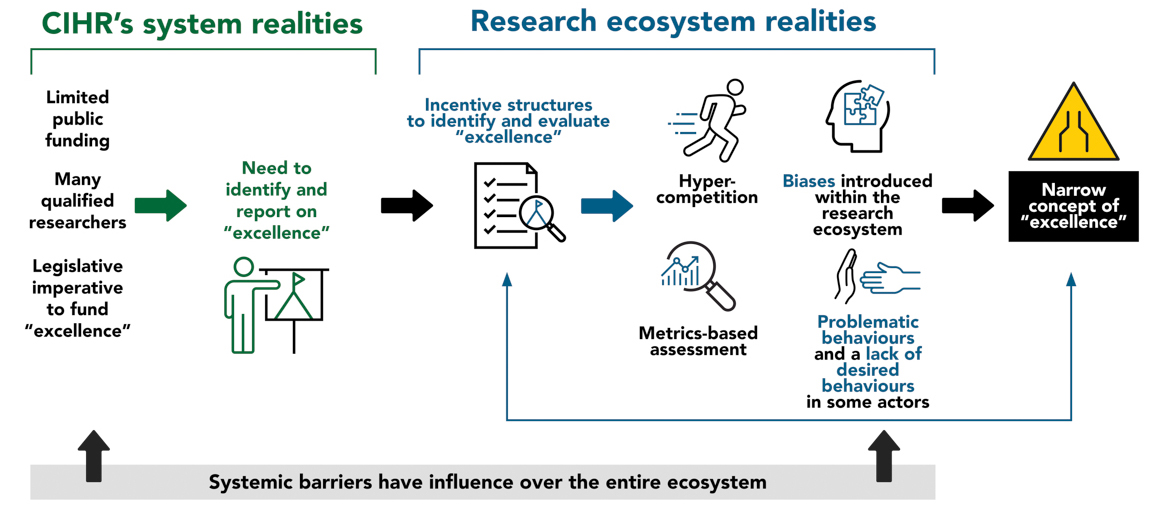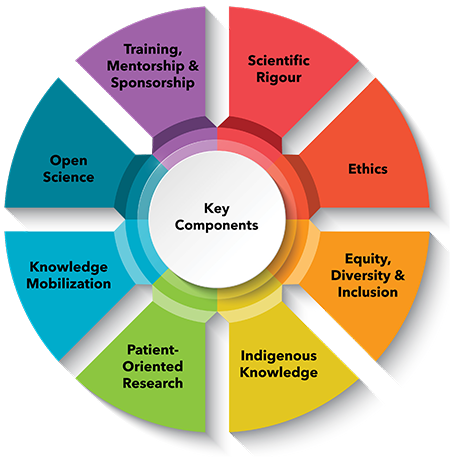Research Excellence at CIHR
On this page
- Message from Rhonda Kropp, Associate Vice-President, Learning Health Systems
- Research Excellence: Current Context
- Research Excellence: Understanding the Issue
- CIHR Research Excellence Framework
- Related links
Message from Rhonda Kropp
Associate Vice-President, Learning Health Systems
I am pleased to announce the release of CIHR's Research Excellence Framework, a major step in advancing our strategic plan commitment to research excellence in all its diversity.
This Framework positions CIHR on a clear path towards achieving our vision where Canadian health research is recognized as inclusive, collaborative, transparent, culturally safe, and focused on real-world impact. We are looking to ensure agency-funded research is scientifically excellent and ultimately leads to impacts that benefit all people in Canada, including those historically underrepresented in the health research system.
We recognize that moving this Research Excellence Framework into practice will require meaningful changes to our policies and programs, and that it will benefit from a holistic, collaborative, and transparent approach. As such, we are also releasing an associated implementation plan that details the suite of early actions we will be taking towards inclusive research excellence.
We are grateful for the many collaborations that informed this work, and we welcome the opportunity to continue learning from others — as we collectively look for ways to improve health and maximize the impact of health research in Canada.
Research Excellence: Current Context
There is significant and growing interest in Canada and internationally in what is meant by research excellence, and how it impacts the research ecosystem.Footnote 1,Footnote 2 This has been made clear through calls for more responsible research assessmentFootnote 3, Footnote 4, Footnote 5, a re-imagining of what is considered excellentFootnote 6, Footnote 7, acknowledgement that research culture can be problematicFootnote 8, Footnote 9, and that current incentive structures are biased.Footnote 10
CIHR is legislated through the CIHR Act to "excel, according to internationally accepted standards of scientific excellence, in the creation of new knowledge and its translation into improved health for Canadians, more effective health services and products, and a strengthened Canadian health care system".Footnote 11 While CIHR's expectations for agency-funded research have evolved over time – as exemplified through its actions related to sex and gender in research, equity, diversity and inclusion, Indigenous Health Research, official languages, patient-oriented research, knowledge mobilization, open access, research data management, and training and mentorship – the agency has never explicitly described how it views research excellence. However, CIHR's 2021–2031 Strategic Plan includes a commitment to advance research excellence in all its diversity, in part through championing a more inclusive concept of research excellence, and so a formal definition is needed.
Research Excellence: Understanding the Issue
To inform its conceptualization of research excellence, CIHR undertook several evidence-gathering activities: a comprehensive literature review; an international environmental scan; and an initial series of discussions with the health research community. These activities informed CIHR's understanding of how problematic behaviours, barriers and biases are limiting what is currently conceptualized as excellent research and who are considered excellent researchers (Figure 1).
Figure 1: Biases, behaviours and perpetuation of systemic barriers associated with a narrow concept of research excellence

Figure 1 – Long Description
In Figure 1, a flowchart illustrates biases, behaviours and perpetuation of systemic barriers associated with a narrow concept of research excellence. The left side of the figure, labeled 'CIHR's ecosystem realities,' highlights factors such as limited public funding, many qualified researchers, legislative imperative to fund "excellence." An arrow extends to the right indicating the need to identify and report on "excellence." On the right, a section labeled 'research ecosystem realities' includes incentive structures to identify and evaluate "excellence," leading to the consequences of hypercompetition, biases introduced within the research ecosystem, metrics-based assessment, and problematic behaviours and a lack of desired behaviours in some actors. Collectively, these elements contribute to a narrow concept of "excellence." Below the headings "CIHR's system realities and Research ecosystem realities," with two arrows pointing up, is the text "systemic barriers have influence over the entire ecosystem."
Evidence demonstrates that existing incentive structures designed to identify excellence have resulted in a hypercompetitive environment and reliance on metrics-based assessment of outputs (such as journal impact factors). Many biases (e.g., racialFootnote 12, Footnote 13, genderFootnote 14, Footnote 15, languageFootnote 16, Footnote 17, program designFootnote 18, and assessment practice biasesFootnote 19, Footnote 20) and behaviours (e.g., contributions to a toxic research environmentFootnote 21, Footnote 22, Footnote 23, limited knowledge mobilizationFootnote 24, Footnote 25, and inadequate mentoring and trainingFootnote 26, Footnote 27) perpetuate a narrow concept of excellenceFootnote 28 — one that does not inherently recognize and value diversity among researchers, research or the full range of research contributions that can address scientific and societal problems. Furthermore, systemic barriers (e.g., physical, geographical, or social) have had a negative impact over the entire research ecosystem and consequently in how research excellence has been defined, pursued, and assessed.Footnote 29, Footnote 30, Footnote 31, Footnote 32
Collectively, these biases, behaviours and barriers reduce the diversity of perspectives, methods and contributions that are rewarded within the research ecosystem, resulting in research wasteFootnote * and minimizing the potential impact of already scarce research funds. Therefore, it is imperative that CIHR broaden its concept of excellence, to ensure agency-funded research has impacts that benefit all people in Canada, including those historically underrepresented in the health research funding system.
CIHR Research Excellence Framework
CIHR's strategic plan envisions that, by 2031, Canadian health research will be internationally recognized as inclusive, collaborative, transparent, culturally safe, and focused on real world impact. To align CIHR's activities and investments towards this vision, CIHR has crafted a definition of research excellence, based on three guiding principles and comprising eight key components.
CIHR recognizes that many other research funders and organizations are exploring the concept of research excellence and ways to reward a broader range of contributions and outputs. As such, CIHR's approach to research excellence will continue to be evidence-informed and will evolve as part of ongoing dialogue with national and international partners as well as the Canadian health research community.
Definition
CIHR believes that excellent research is rigorous, inclusive and conducted in ways that meaningfully integrate a diversity of perspectives, disciplines, and methods in order to maximize impact and benefit to society.
Excellent research recognizes that biological, socio-economic, cultural and experiential differences impact health and should be considered for research and related activities to be of benefit. An inclusive concept of research excellence positively influences who sets research priorities; who conducts, participates in and benefits from research; how research is conducted; and how it is assessed.
Guiding Principles
The following foundational principles will guide CIHR's work in integrating a more inclusive approach to research excellence across its programs, policies and practices:
- Holistic: Research excellence is broad and spans how research is conceptualized, prioritized, taught, carried out, assessed, funded and used.
- Adaptable: Research excellence is not one-size-fits-all, but rather context- and content-specific. Flexible, catered approaches are required to recognize and incent the breadth of research within CIHR's mandate.
- Evergreen: Research excellence is a concept designed to be adjusted as new evidence emerges, and as science and society evolve.
Key Components

The following key components should be considered and addressed within all CIHR-funded research whenever relevant and appropriate:
- Ethics: Excellent research must meet international standards of ethics.
- Equity, Diversity, and Inclusion (EDI): Research is excellent when it is inclusive, equitable, diverse, anti-racist, anti-ableist, and anti-colonial in approach and impact. Excellent research reflects the diversity of scientific talent in Canada, empowers participation of communities historically marginalized and disadvantaged in health research (including but not limited to women, Francophone researchers, Indigenous Peoples and organizations, persons with disabilities, and Black and other communities marginalized by race), and supports inclusion across the lifespan for research involving humans. Within this component, it should be especially noted that the right to conduct research in the official language of one's choice, which is protected through the Official Languages Act, is a key pillar of inclusion.
- Indigenous Knowledge: Guided by a spirit of reconciliation and co-existence, research must prioritize requirements of First Nations, Inuit and Métis communities and respect the self-determination of Indigenous Peoples. This involves building trust, respect and relationships with communities; recognizing Indigenous knowledge systems; learning and understanding culture; co-producing research to ensure questions and approaches are shaped by community priorities and remain in the community; presenting findings using accessible and community-centric approaches; and respecting Indigenous data sovereignty.
- Patient-Oriented Research: Excellent research includes meaningful engagement of patients, people with lived and living experience, and other knowledge users as partners throughout the entire research process. This approach helps to ensure questions and results are relevant and enhance the integration of findings into the health care system and clinical practice, with the goal of improving patient experiences and outcomes.
- Knowledge Mobilization: Excellent research employs tailored approaches for optimizing the impact of agency-funded research. Excellent research involves co-designing research priorities and questions with knowledge users, and/or mobilizing findings via a broad range of accessible and equitable formats to inform health-related decisions by policy makers, practitioners, patients and communities.
- Open Science: Excellent research incorporates open science practices that enable timely access and sharing of research findings, data and other outputs, in order to maximize the use and impact of agency-funded research.
- Scientific Rigour: Excellent research must use robust research designs that minimize bias across methodologies, analysis, interpretation and transparent reporting of results.Footnote 33
- Training, Mentorship and Sponsorship: CIHR recognizes the importance of training, mentorship and sponsorship in creating and supporting the diversity of talent needed to conduct excellent research. This includes valuing efforts to address gaps in training and support across all career stages, transitions, and paths, and to build capacity amongst groups currently underrepresented in the health research ecosystem.
Related links
CIHR links:
Footnote
- Footnote *
-
Research waste refers to poor-quality research output that fails to advance scientific understanding, provides limited or no return on investment, and is often perceived as of minimal use to policy makers and clinicians.
References
- Footnote 1
-
Global Research Council (GRC): Responsible Research Assessment [ PDF (4.26 MB) - external link ]
- Footnote 2
- Footnote 3
- Footnote 4
- Footnote 5
- Footnote 6
-
Research on Research Institute (RoRI): 'Excellence' in the Research Ecosystem
- Footnote 7
-
Room for everyone's talent (Dutch public knowledge institutions and research funders)
- Footnote 8
- Footnote 9
- Footnote 10
- Footnote 11
- Footnote 12
- Footnote 13
- Footnote 14
-
Assessment of potential bias in research grant peer review in Canada
- Footnote 15
- Footnote 16
-
The role of Canadian federal research funding agencies in the promotion of official languages
- Footnote 17
- Footnote 18
- Footnote 19
-
The Matthew effect in science funding [ PDF (598 KB) - external link ]
- Footnote 20
- Footnote 21
-
The Perverse Effects of Competition on Scientists' Work and Relationships
- Footnote 22
- Footnote 23
-
Challenging social structures and changing research cultures
- Footnote 24
- Footnote 25
- Footnote 26
- Footnote 27
- Footnote 28
-
"Excellence R Us": university research and the fetishization of excellence
- Footnote 29
-
Revising the a Priori Hypothesis: Systemic Racism Has Penetrated Scientific Funding
- Footnote 30
-
Racism, equity and inclusion in research funding [ PDF (5.98 MB) - external link ]
- Footnote 31
- Footnote 32
- Footnote 33
- Date modified: